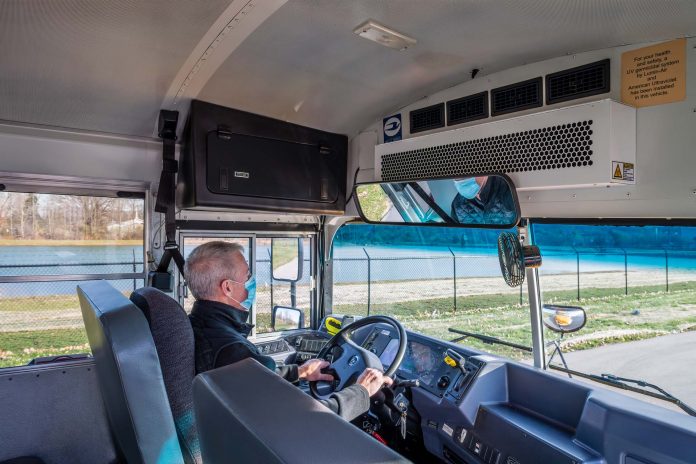School buses are the most densely populated areas of a school facility and they inherently have poor air quality. As previously reported, funding is available through the Coronavirus Aid, Relief, and Economic Security (CARES) Act and the Consolidated Appropriations Act of 2021 to clean the air in school buses. Additional funding is included in the American Rescue Plan.
The options available for cleaning the air on your school buses can be overwhelming. There are so many terms to consider: cubic feet per minute (CFM), clean air delivery rate (CADR), ultraviolet C light (UVC), etc. How do you determine what is best for your fleet?
First: Whichever solution you choose, you’re going to be questioned by the public that you serve. So, keep that in consideration if you are going to choose a technology that isn’t recommended by the Centers for Disease Control and Prevention. The CDC recommends improving particulate filtration and using UVC, any other technologies are considered “emerging technology without an established body of evidence.”
As the American Society of Heating Refrigeration and Air Conditioning Engineers recently pointed out, emerging technologies such as ionizers, UV-PCO, and others claim to remove or destroy multiple types of contaminants. But in doing so, they may convert them to other harmful compounds.
If a technology claims to kill or inactivate SARS-CoV-2 cells, make sure you can explain how the system is still completely safe for students and drivers. If it’s not “safe” for virus cells, is it safe for human cells? If you can’t explain it, choose something else.
Second: To help consumers compare the effectiveness of various air cleaning solutions, the CDC references the EPA’s Guide to Air Cleaners in the Home. In that guide, “efficiency” and “effectiveness” are defined by the term “Clean Air Delivery Rate,” or CADR, the product of efficiency and airflow. Effectiveness takes into account how much of the air you’re cleaning. An air cleaner that is 100 percent efficient at cleaning 300 cubic feet per minute (CFM) of air would have a CADR of 300. An air cleaner that is 90 percent efficient at cleaning 1,000 CFM of air would have a CADR of 900 and be three-times as effective. CADR provides you with a metric for comparing various systems.
Ask the following questions when looking to purchase air filtration systems:
Is the air cleaning technology endorsed by the CDC?
Is the air cleaning technology safe and effective?
What is the airflow (CFM) of the air cleaning system?
What is the efficiency of the air cleaning system?
What is the dust holding capacity of the air cleaning system?
What is the initial cost?
What is the annual cost, considering consumable items, like replacement filters and UVC bulbs?
A simple CADR calculator can be found at www.lumin-air.com. Simply enter the airflow and efficiency of the air cleaner and the CADR is calculated. To put the CADR number in terms people can relate to, the output shows the clean air percentage of a bus’s air conditioning system. It also shows how much airflow that is relative to a typical handheld hairdryer. For example, if you calculated a CADR of 350 CFM, would you feel it was adequate to only clean 10 percent of a 66-passenger bus air conditioning airflow? 350 CFM is the airflow of just over four hair dryers. You’d likely want to have many of these smaller systems located throughout the bus.
Third: Consider not only the initial purchase cost but the ongoing cost of anything you install. While your school system can get funds for the initial installation of air cleaning systems on your buses, this is one-time funding. Calculate the ongoing cost of the system. Ask vendors to include five-year parts warranties and five years or more of replacement filter changes in their quotes.
How do you know when to change filters? As filters load with dust and contaminants, the pressure drop across them increases, which reduces airflow. Reducing airflow, reduces your CADR, which reduces the effectiveness of your system. The rule of thumb for changing filters is to replace them when the pressure drop across them doubles from their initial clean pressure drop. Pressure drop is related to the dust holding capacity of the filter. Filters with high dust holding capacity last longer than filters with low dust holding capacity. You’ll have to replace dirty filters with clean filters based on how quickly they reach their dust holding capacity. So, make sure vendors provide the dust holding capacity of their filters and cost of replacement filters for comparison.
While it’s great that school buses are getting the attention and funding they deserve to clean the air inside school buses, it’s important to safely achieve the highest level of disinfection for the least amount of money over the lifespan of the system.
 Dan Fillenwarth is the president of Lumin-Air.
Dan Fillenwarth is the president of Lumin-Air.
















